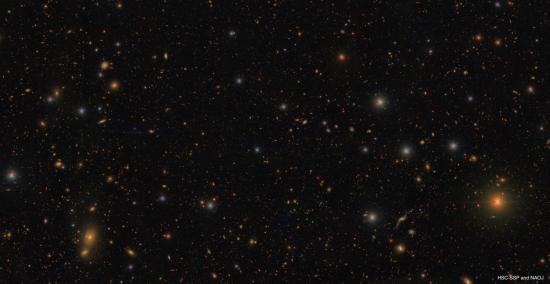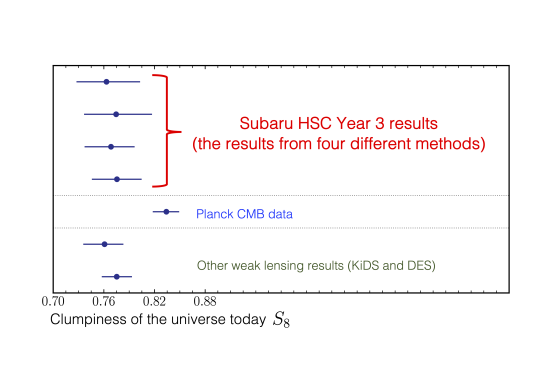April 4, 2023
Kavli Institute for the Physics and Mathematics of the Unvierse (Kavli IPMU)


An international team of astrophysicists and cosmologists at various institutes including the Kavli Institute for the Physics and Mathematics of the Universe (Kavli IPMU) have submitted a set of five papers, measuring a value for the “clumpiness” of the universe’s dark matter, known to cosmologists as S8, of 0.76, which aligns with values that other gravitational lensing surveys have found in looking at the relatively recent universe — but it does not align with the value of 0.83 derived from the Cosmic Microwave Background, which dates back to the universe’s origins when the universe was about 380,000 years old. Their results were uploaded as pre-print papers on April 3.
The gap between these two values is small, but as more and more studies confirm each of the two values, it doesn’t appear to be accidental. The possibilities are that there’s some as-yet unrecognized error or mistake in one of these two measurements or the standard cosmological model is incomplete in some interesting way.
Dark energy and dark matter make up 95% of our universe we see today, but we understand very little about what they actually are and how they’ve evolved over the history of the universe. Clumps of dark matter distort the light of distant galaxies through weak gravitational lensing, a phenomenon predicted by Einstein’s General Theory of Relativity.
“This distortion is a really, really small effect. The shape of a single galaxy is distorted by an imperceptible amount. But combining the measurements for millions of galaxies allows one to measure the distortion with quite high precision,” said Kavli IPMU Professor Masahiro Takada.
The standard model is defined by only a handful of numbers: the expansion rate of the universe, a measure of how clumpy the dark matter is (S8), the relative contributions of the constituents of the universe (matter, dark matter, and dark energy), the overall density of the universe, and a technical quantity describing how the clumpiness of the universe on large scales relates to that on small scales.
Cosmologists are eager to test this model by constraining these numbers in various ways, such as by observing the fluctuations in the Cosmic Microwave Background, modeling the expansion history of the universe, or measuring the clumpiness of the universe in the relatively recent past.
A team led by astronomers from Kavli IPMU, the University of Tokyo, Nagoya University, Princeton University, and astronomical communities of Japan and Taiwan, have spent the past year teasing out the secrets of this most elusive material, dark matter, using sophisticated computer simulations and data from the first three years of the Hyper Suprime-Cam survey. The observations from this survey used one of the most powerful astronomical cameras in the world, the Hyper Suprime-Cam (HSC) mounted on the Subaru Telescope on the summit of Maunakea in Hawaii.
Hiding and uncovering the data
The team performed a “blinded analysis”.
“Scientists are human beings, and they do have preferences. Some would love to really find something fundamentally new, while others might feel comfortable if they find results that look consistent with foreseen results. Scientists have become self-aware enough to know that they will bias themselves, no matter how careful they are, unless they carry out their analysis without allowing themselves to know the results until the end,” said Nagoya University Kobayashi-Maskawa Institute for the Origin of Particles and the Universe (KMI) Associate Professor Hironao Miyatake.
To protect the results from such biases, the HSC team hid their results from themselves and their colleagues for months. The team even added an extra obfuscating layer: they ran their analyses on three different galactic catalogs, one real and two fake with numerical values offset by random values. The analysis team didn’t know which of them was real, so even if someone did accidentally see the values, the team wouldn’t know if the results were based on the real catalog or not.
The team spent a year on the blind analysis. On December 3 2022, the team gathered together on Zoom – one Saturday morning in Japan, Friday evening in Princeton – for the “unblinding”. The team unveiled the data, and ran their plots, immediately they saw it was great according to Takada. “Blinded analysis means you cannot take a peak at the results while running the analysis, which was extremely stressful, but as soon I saw the final result, all of that anxiety flew out of the window,” said Kavli IPMU graduate student Sunao Sugiyama.
A huge survey with the world’s largest telescope camera
HSC is the largest camera on a telescope of its size in the world. The survey that the research team used covers about 420 square degrees of the sky, about the equivalent of 2000 full moons. It is not a single contiguous chunk of sky, but split among six different pieces, each about the size of a person’s outstretched fist. The 25 million galaxies the researchers surveyed are so distant that instead of seeing these galaxies as they are today, the HSC recorded how they were billions of years ago.
Each of these galaxies glows with the fires of tens of billions of suns, but because they are so far away, they are extremely faint, as much as 25 million times fainter than the faintest stars we can see with the naked eye.
Paper details (5 papers)
Miyatake, H., Sugiyama, S. et al. 2023, Hyper Suprime-Cam Year 3 Results: Cosmology from galaxy clustering and weak lensing with HSC and SDSS using the emulator based halo model
Pre-print (arXiv.org)
More, S., Sugiyama, S. et al. 2023, Hyper Suprime-Cam Year 3 Results: Measurements of the clustering of SDSS-BOSS galaxies, galaxy-galaxy lensing and cosmic shear
Pre-print (arXiv.org)
Sugiyama, S. et al. 2023, Hyper Suprime-Cam Year 3 Results: Cosmology from galaxy clustering and weak lensing with HSC and SDSS using the minimal bias model
Pre-print (arXiv.org)
Dalal, R. et al 2023, Hyper Suprime-Cam Year 3 Results: Cosmology from cosmic shear power spectra
Pre-print (arXiv.org)
Li, X. et al. 2023, Hyper Suprime-Cam Year 3 Results: Cosmology from cosmic shear two-point correlation functions
Pre-print (arXiv.org)
Research contact
Masahiro Takada
Professor
Kavli Institute for the Physics and Mathematics of the Universe (Kavli IPMU)
The University of Tokyo
E: masahiro.takada_at_ipmu.jp
* Please change _at_ to @
Media contact
Motoko Kakubayashi
Press officer
Kavli Institute for the Physics and Mathematics of the Universe (Kavli IPMU)
The University of Tokyo
TEL: 04-7136-5980
E-mail:press_at_ipmu.jp
* Please change _at_ to @
Related links
Summary of the main results (mainly for astronomers)
[Research] How to see the invisible: Using dark matter distribution to test our cosmological model (Kobayashi-Maskawa Institute for the Origin of Particles and the Universe)
How to See the Invisible: Using the Dark Matter Distribution to Test Our Cosmological Model (Subaru Telescope)
Related articles
Forty new studies published from first data of world's biggest map of the Universe (2018)






